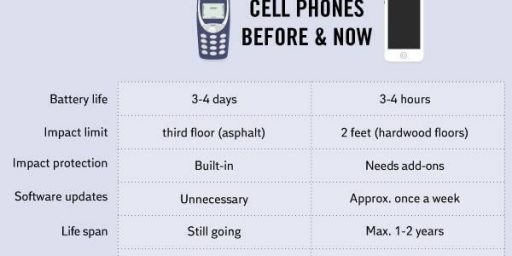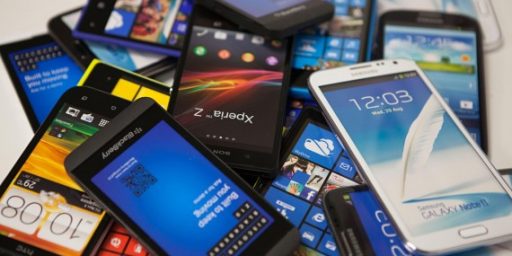U.S. Behind in Wireless
U.S. lags behind much of developed world in wireless (CNN)
An estimated 57 percent of the U.S. population chats on wireless phones — not much greater than the percentage of wireless phone users in much poorer Jamaica, where 54 percent of the people have mobile phones, according to the International Telecommunications Union. By comparison, in Hong Kong there are 105.75 mobile subscribers for every 100 inhabitants. In Taiwan, there are 110.
My initial reaction was to note that Jay Leno’s garage would hold both Hong Kong and Jamaica, making the comparison rather silly. But there’s actually more to the story:
Wireless networks elsewhere are simply better than those in the United States, said Albert Lin, an analyst at American Technology Research. “For a long time, the U.S. had way too many networks being supported by not enough investment,” he said. “The quality of U.S. networks is only now coming close to the quality you would see in major European and Asian markets.” Not that the European model was perfect: Companies there paid $125 billion for licenses to operate “third-generation” mobile networks that enable European users to zap videos and data by phone. The result: Mountains of debt, but a chance to sell phones packed with features James Bond would love.
***
Another reason for lower cell phone use in the United States is how service is sold. The largest carriers sell phones by subscription, requiring a credit check and a commitment of at least one year. “We have tapped out the prime-credit segment in the U.S.,” said Roger Entner, a Yankee Group analyst. “Everyone who wants to have a wireless phone and can pass a credit check has one. Everyone who can pass a credit check and doesn’t have one — after ten years of a continuous barrage (of advertising), they’re not going to cave.”
I am a bit astounded by coverage gaps. I understand not being able to get cell coverage out in the middle of nowhere–here, our gigantic land mass and thin population density work against us–but there are places in the highly populated, affluent D.C. suburbs where one can not get a signal. That’s simply bizarre.
This is interesting:
The next generation of wireless users may be machines, not people. Services such as OnStar, a subsidiary of General Motors Corp., use a combination of cell phones built into cars and Global Positioning Systems, to call for help in emergencies, Lin said. Cars that call 911 when air bags are deployed use the same technology. Similar systems are being built for vending machines to call a central office to say they need to be refilled and to monitor oil and gas company equipment used in harsh climates and using wireless networks to transmit video ads to screens in malls. “People who think we’re at a point of saturation are not including all the possible uses of technology,” Lin said.
I suspect he’s right.






Unfortunately, highly populated affluent suburbs are the hardest place to get any kind of tower built. And right now terrestrial towers are the only way to get signal into residential neighborhoods in a cost effective fashion. One of the great ironies of NIMB (Not in my backyard) is that the people are most opposed to new towers are the first ones to complain when they drop a call in their house.
James,
I worked for Motorola for a couple of years, in the cellular infrastructure group, and have a bit of insight (though not much). Europe, as with the rest of the world, imposed an early digital cellular standard and the U.S. did not, preferring to let the standards compete and let the better one win.
The outcome — which approach is best — still isn’t clear to me. Europe and Asia seem to be moving right along with their cellular networks, while things tend to drag a bit here. We still have multiple technologies at work, but seem to be doing OK — we’re not horribly behind. If a better technology comes along, we’ll be in a better position to adapt to it than the rest of the world. The price we pay for that flexibility is a lack of uniformity.
On the whole, I’m not all that troubled. Moreso than other countries, we tend to have more practical tastes when it comes to gadgetry (there was a SF Chronicle article on this the other day) and don’t stay on the bleeding edge, except where business is concerned. That seems about right to me.
What I don’t understand is why portions of the Pennsylvania Turnpike don’t have Verizon coverage (at at times, any coverage at all).
I mean come on! Its the PA Tunrpike, the most traveled route from Pittsburgh to Philly! Its not like the country roads leading to my hometown.
Unfortunately, highly populated affluent suburbs are the hardest place to get any kind of tower built.
That’s all that needs to be said on the coverage question.
On the machines using cell phone- that is exploding as we speak.
Last year I worked on a contract where we digitized pumping stations. When the station has a pump down or has a flood condition it calls via cell phone and lets the county maintenance dept know what the problem is. I forget but I think we had like 4 different conditions it would call for.
All that is sucked into a computer and gets logged into a database then text messages are sent to people in the field. Stunning technology that cost next to nothing. (in municipality terms)
The article is pretty much dead on. Several problems. It is not so much the money, but the time, in putting a tower up. The regulations are amazing. And, everyone wants coverage, but do not want to see a tower. Catch 22. The rest of the world pretty much switched to digitial years before the US did, so we are lagging behind. What people in other countries do with their phones, text messaging, interenet, etc, is just not a big deal here in the US. Even those with good credit are not paying their bills.
Wireless has achieved such high penetration in certain developing nations because there is no landline infrastructure to speak of and where there is infrastructure, it is old, low quality, too expensive or some combination thereof. They also had entrenched interests in the PTT’s which did not see any utility in having a wireless competitor.
As for Europe, their early analog cellular systems were a nightmare, and generally prohibited cross border travel due to non-compatibility between networks and no settlements mechanism. They got together and hammered out the GSM open network standard. All networks would be built to the same spec and carriers would compete based on feature set (SMS, handset functionality, etc.)and coverage. When the US finally licensed 2 GHz PCS here in the US, the first commercial network to go live was APC’s GSM system in Washington, D.C. Omnipoint’s followed shortley thereafter with a GSM system in New York City. Omnipoint eventually merged with Voicestream which eventually was bought by T-Mobil. APC quickly sold out to Sprint Spectrum which eventually transitioned to a CDMA network. Key point: APC and Omnipoint exploited GSM open standard because it was the only “cheap” system ready to go off the shelf. CDMA, a standard championed by Qualcomm, had yet to prove itself. it has since done so.
One aspect perhaps lost int he article in the geographic licensing of PCS. US digital cellular licenses were awarded via an auction methodology. This raised the cost of building a network tremendously. In addition, although the geographic scope of the larger licenses MTAs and BTAs) were much bigger than the MSA of analog cellular licenses, they were not national in scope nor even encompassing of major megalopolis’ such as the New York-D.C. corridor. Different companies owned different licenses. That, in addition to the different technology choices confronting the license holders, slowed down the buildout.
My understanding has always been that our progress was slowed down by the fact that we have such good landlines, and don’t “need” cellular technology as they do in other countries (even industrialized ones). To us, cells are a convenience only.
I’m not so sure our place in the wireless world is as doomy and gloomy as the CNN article makes it sound. John Yunker’s blog, Unwired, had a post a few days ago about how the U.S. is close to surpassing Europe in network speeds and bandwidth consumption.